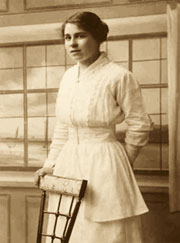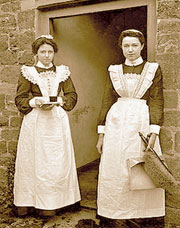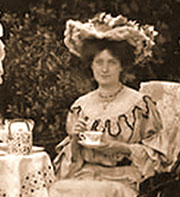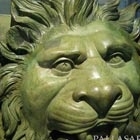Find out about what bronze patinas are, how they are applied, popular colors and finishes for railings, gates sculptures and metal art objects.
Serving Luncheon, Compromise Style
Lace-trimmed and elaborately embroidered tablecloths, or those that are embellished with drawn work, are frequently selected for use on the luncheon table. But often the cloth is discarded, and a centrepiece, with individual doilies for each article to be set upon the table, are chosen. Napkins of a smaller size than the dinner napkin are preferred for this meal. Fine lace or drawn-work doilies, laid under the service plate, are quite small, affording space for the plate and one spoon (bouillon) or knife and fork, respectively. All other silver is set in place as needed. Occasionally plate doilies of fine crash, handsomely embroidered, are of larger size.
If the cloth be lace-trimrned or ornamented with drawn work, a delicately tinted silk lining is generally used over the silence cloth, and the dishes, from preference, are served from the side.
STYLE OF SERVING LUNCHEONS
A. formal luncheon is usually served after the Russian style of service, and the directions given for serving dinner will suffice for this meal also. Family luncheons are often served in English fashion from the table; and the directions given for serving breakfast will suffice for serving a luncheon after this style. The compromise style of serving, described on page 34, is probably the one most largely in vogue for luncheons, and it is here described in detail. On a table, without cloth, the luncheon is served satisfactorily only after the Russian fashion.
MENU
Grape Fruit.
Bouillon.Olives. Oysters, Manhattan Style. Brown-bread Sandwiches. Chicken Timbales, Mushroom Sauce. Little Fillets of Beef, Spanish Sauce.
French Fried Potatoes. Lettuce, French Dressing. Pulled Bread.Cheese Balls. Angel Parfait. Little Cakes. Bonbons. Coffee.
Directions are given for serving the above menu up to the salad after the Russian style. Beginning with the salad, the instructions are for serving in the English manner. The combination of the two styles results in what is known as the "compromise" style of service.
LAYING THE TABLE
We will suppose that the cloth has been laid according to the directions previously given. A bowl of flowers stands on a centrepiece in the centre of the table. Think of the "plate line" as an imaginary line extending around the table fifteen or sixteen inches from the edge. Just inside this line set candelabra or candles, at points equidistant from each other and the centre of the table. Between these set dishes of salted almonds and bonbons. Olives, which are served upon bits of ice, should not be placed upon the table. Now, according to the instructions previously given, set in place the following items:
Service or place plates (ten inches in diameter).
Spoons for grape fruit. (Set these above the plate or first in order at the right.)
Spoons for bouillon.
Forks for oysters (those used for raw oysters).
Small forks for tirnbales.
Knives and forks for fillets of beef.
Salad forks.
Tumblers for water.
Glasses for wine or Apollinaris.
Napkins. (Later on insert a roll or piece of bread between the folds.)
Individual butter plates. (Supply balls of butter later on.)
(Bread-and-butter plates, with spreaders, are less formal than the individual butter plates, and are reserved for breakfast and informal luncheons.)
THE SIDEBOARD WHEN LUNCHEON IS ANNOUNCED
When luncheon is announced, the following items should be in order upon the sideboard:
A carafe of chilled water, either with or without a bowl of ice, in bits, with spoon.
Extra supply of butter.
Extra supply of bread.
Sandwiches to serve with oysters.
Olives in fancy dish.
Cruets of oil and vinegar.
Salad fork and spoon.
Ice-cream forks or spoons.
Cut sugar for coffee.
Finger-bowls on plates, doilies between.
THE SIDE-TABLE WHEN LUNCHEON IS ANNOUNCED
When luncheon is announced, the following items (for this menu) should be found disposed in an orderly manner upon the side-table:
Tablespoon to serve timbales.
A carving fork of small size and a tablespoon to serve the beef.
After-dinner coffee spoons.
A tray covered with a doily.
Two or three napkins and towels for emergencies.
The bouillon cups and plates for the oysters, the plates for the timbales and the fillets of beef should be in the warming oven.
The plates for the salad and ices should be in the refrigerator, preferably one standing in the butler's pantry.
A second side-table, or a dinner wagon, set on castors, affords means to expedite the service when the number of attendants is limited.
THE TABLE WHEN LUNCHEON IS ANNOUNCED
When luncheon is announced, the grape fruit, prepared according to directions given on page 79, is in place on fancy plates (a lace-paper doily between) set upon the service plates, the tumblers are filled to two thirds their height with water or bits of ice and water, and each individual dish is supplied with butter. At a very formal luncheon or dinner the butter is omitted.
REMOVING THE GRAPE-FRUIT COURSE
Beginning at the right of the hostess, remove the grape-fruit plates from the right. Remove them, one at a time, or one in each hand, to the pantry. Leave the service plate in position.
SERVING THE BOUILLON
Now bring in the bouillon cups and saucers, one at a time, one in each hand or two (no more) on a tray, borne on the flat of the hand, a napkin between, as is most expedient under the circumstances, and set them upon the service plates, in each hand, set them down upon the service plates from the right. Return to the pantry for the platter of timbales, take the tablespoon from the side-table, and put it on the platter, then, carrying the platter upon a folded napkin laid upon the flat of the left hand, pass to the right of each, and serve the timbales, or pass to the left, and let each one help herself. When the waitress serves the timbales, there need be no break in the conversation. She also usually understands how to handle them better than does the guest.
Pass bread to the left of those needing it.
Refill tumblers with water.
Remove the timbale plates from the right, leaving the service plate.
SERVING THE FILLETS OF BEEF AND POTATOES
Bring to the side-table the hot plates for the fillets of beef, then, taking a plate in the left hand and commencing on the left of the hostess, take up the service plate and set the hot plate in its place. When all are thus provided with hot plates, bring in the fillets of beef with sauce on a platter on the flat of the hand, set a spoon upon the dish, and, passing to the right of each, serve the fillets.
Return to the pantry for the dish of potatoes, and serve these in the same manner. This dish, being smaller than the platter of meat, if preferred, may be carried on the tray.
Thus far the meal has been served after the Russian fashion. From now on, through the meal, the English fashion will be followed.
SERVING THE SALAD
Set a silver or china tray before the hostess. Upon this set a bowl of lettuce, carefully washed and dried, the salad fork and spoon, bottles of oil and vinegar, a dish of salt, and another of paprika. While the salad is being dressed, bring in the cold salad plates. Take one in each hand, set one down before the hostess, and, when a portion of salad has been placed upon it, take this up and set down the other plate. Place the plate of salad before the first at the right of the hostess. Now take another plate from the sideboard, take up the second prepared plate, replacing it with the one in the other hand, and set it before the second in order
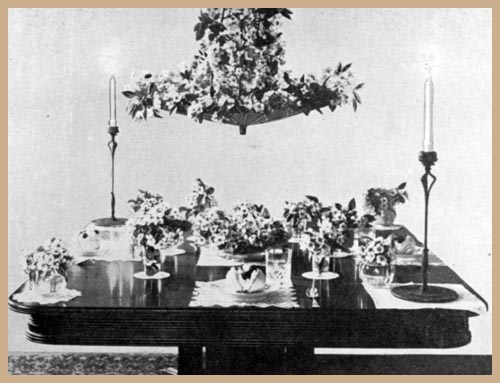 Above: May-Day Luncheon Table (Dessert Service)
Above: May-Day Luncheon Table (Dessert Service)
When all are served, bring in the cheese balls, on a plate covered with a paper doily, and the pulled bread, together on the tray, and pass to the left, that each may help herself.
SERVING THE SWEET COURSE
Remove the crumbs by means of a small folden napkin and a breakfast plate or bread-and-butter plate. (See page 46, rule 7). Set the dish of parfait before the hostess, with the slicer at the right.Return to the sideboard for two plates; put one before the hostess, and, when she has disposed the ice upon it, replace it with the other plate, and set the plate of cream before the guest at the left of the hostess.Repeat until all are served. Pass the plate of cake to the left, that each may help herself. Remove the plates, one in each hand. Bring in the finger-bowls on fancy plates, with doilies between, one in each hand. Set these down from the right. Pass the bonbons to the left, that each may help herself. The bonbons being eaten, take out these plates, one in each hand, and bring in two coffee cups on a tray* Set these down from the right. When all are served, return with sugar and cream or sugar alone, on the tray, and pass to the left, that those who wish may help themselves.
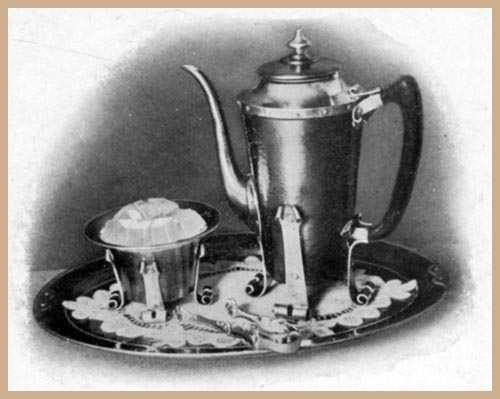 Above: After-Dinner Coffee Service for Library
Above: After-Dinner Coffee Service for Library
COFFEE SERVED IN LIBRARY
The coffee is often served in the library or reception-room. The waitress may bring it in, in after-dinner cups on a tray, and return for the sugar; or the after-dinner coffee service coffee pot with cups and sugar bowl (no creamer) may be brought in on a larger tray, and set down on a table, at which the hostess seats herself to pour the coffee. The maid passes the cups on a tray, and afterwards passes the sugar. She remains to gather up the cups and remove all traces of the service.
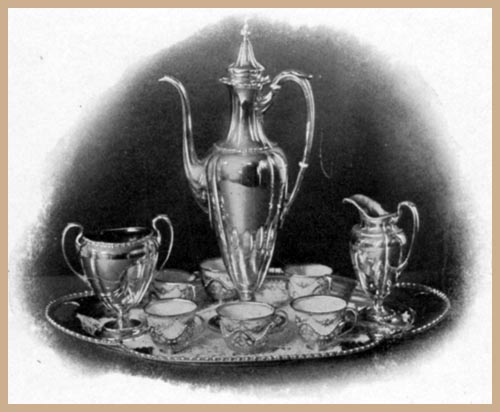 Above: After-Dinner Coffee Service for Table or Library
Above: After-Dinner Coffee Service for Table or Library
CREME DE MENTHE SERVED IN LIBRARY
At a luncheon party, when coffee is served at the table, creme de menthe is occasionally passed after the guests are seated in the library. Tiny cordial glasses are partially filled with fine-shaved ice and over this is poured a tablespoon full of sugar syrup mixed with creme de menthe cordial. These are set on very small doily-covered plates, an after-dinner coffee spoon beside each glass. The plates are passed, two at a time, on a tray.
In English and compromise style of service the waitress stands at the left of the host or hostess when serving down a plate or taking up a plate or other article prepared for serving.
Wheter the host (or hostess) or the waitress set the plate or cup (cofee or tea) made ready for serving upon the tray is a matter to be decided by each individual host. We are however inclined to think that it should be done by the waitress. When no tray is used the waitress lifts the plate.Why change because a small tray is in one hand?
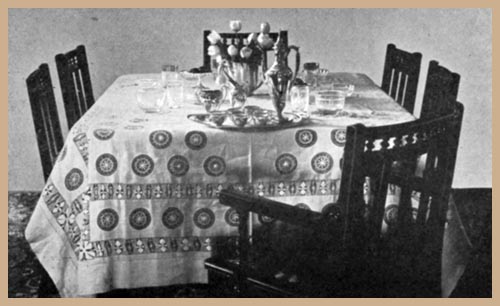 Above: Coffee Service at Luncheon Table, Russian Style
Above: Coffee Service at Luncheon Table, Russian Style
VARIABLE POINTS IN THE TABLE SERVICE
The prevailing forms considered to be in accord with good usage in matters of table service change from time to time; though not nearly so frequently as fashions in dress, etc. There are also, always, a few points which are allowed to be a question of the individual taste or judgement of the hostess.These will consequently be found to vary not only in different families, but at different times in the same family. Such a point concerns the placing of a salad to be eaten with the fish or game course. In this case no extra fork is placed for the salad, which is eaten with the fork for the fish or game, respectively. But whether, when it is served on a separate plate, it shall be placed at the right or at the left of the guest is a point to be referred to the hostess, who will decide according as she thinks the comfort and convience of the guest is best furthered.
Another and more important point for the waitress to submit to the judgement of the hostess relates to the person to be served the first to any course. The alternate method, beginning the service of the first course at the right of the host, and the next at his left, is a common usage; but if the guest seated at the host's right - the place of honor - is one of great distinction, every course is frequently served first to such a one.Where the alternate method is used care should be taken to plan it so that: (1) the guest seated at the host's right shall be served first to the three chief courses of the dinner, which are the soup, the roast, and the sweet; and (2) that the guest of honor shall never be the least one to be served. This can be managed by serving from the left of the host only as far as the foot of the table, then resuming it from his right.
At formal luncheons and other occasions where the hostess presides at the head of the table, she will often give instructions that the service shall begin with her. Otherwise the guests seated in her neighborhood will not commence to eat until she is served. Also if a foreign dish, or a novel one, is on the menu, the hostess will be able to set the example of how to deal with it correctly when she is the first to be served.
In the compromise style of serving a luncheon the invitation to a second helping of any dish is sometimes extended by the hostess, who, if the guest accepts, will direct the waitress to offer the dish. Or the hostess will quietly, without formal invitation to the guest, notify the waitress to bring around the dish. Or she may direct the waitress, before the opening of the meal, to pass the dishes a second time to every-one as soon as she sees one or more plates empty. But all of these methods and devices carry the implication of anything but a perfectly trained waitress, for it should be the duty of the waitress completely to relieve the hostess of this care - thus allowing her to devote herself wholly to the entertainment of the company - by taking it upon herself to attend to the wants of the guests, and to be alert to notice when to bring the dish to each one and silently to offer the second helping.
